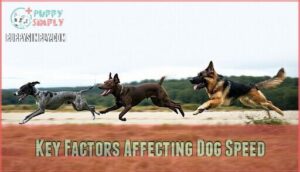This site is supported by our readers. We may earn a commission, at no cost to you, if you purchase through links.

But speed isn’t a one-size-fits-all trait in the canine world. Your neighbor’s Bulldog and that sleek Saluki at the park exist on opposite ends of the spectrum, shaped by centuries of selective breeding for different jobs.
Understanding what determines how fast your dog can run—and what affects their performance—helps you keep them safe, healthy, and enjoying every sprint. From breed genetics and body structure to age and terrain, multiple factors work together to define your dog’s natural pace and endurance limits.
Table Of Contents
Key Takeaways
- Most dogs run 15-20 mph on average, but breed genetics create dramatic differences—Greyhounds hit 45 mph while Bulldogs struggle with basic sprints due to respiratory limitations.
- Your dog’s speed depends on multiple factors working together: breed-specific body structure (leg length, chest depth, spine flexibility), age and weight, health conditions, and even the terrain they’re running on.
- The double-suspension gallop—where all four paws leave the ground twice per stride—gives sighthounds like Greyhounds and Salukis their exceptional speed advantage through efficient energy transfer and spine flexibility.
- Safe running requires matching activities to your dog’s natural abilities, using proper equipment (harnesses over collars), monitoring for overheating signs, and providing water every 15-20 minutes since dogs can’t cool down through sweating.
How Fast Can a Dog Run?
Dogs are faster than you might think, with speeds ranging from a leisurely jog to blistering sprints that rival professional athletes.
Your dog’s top speed depends on breed, build, and overall health.
Let’s break down what you need to know about canine running speeds.
Average Dog Running Speeds
Most dogs can run between 15 and 20 miles per hour, though this average speed varies widely based on breed genetics, size, and individual variation. Mixed breed averages fall within this range, but factors affecting dog speed—like age, weight, and health—create significant differences.
Speed measurement methods, including GPS trackers and timed tests, help you accurately assess your dog’s running speed. Understanding typical breed speeds and these speed influencing factors ensures realistic expectations for your companion’s athletic abilities.
Some breeds, like Greyhounds, can achieve impressive speeds, with Greyhounds reaching 45 mph.
Top Speeds by Breed
When you look beyond those averages, breed speed factors reveal dramatic differences across dog breeds. The Greyhound holds the title as the fastest dog breed, with Greyhound acceleration reaching 45 mph thanks to its double-suspension gallop and flexible spine. Saluki endurance allows these ancient dogs to hit 42 mph over longer distances, while Whippet agility propels them to 35 mph despite their smaller size. Deep chests contribute to their impressive lung capacity.
Top performers by breed include:
- Greyhounds – Consistently clock 35-40 mph in racing, with maximum speeds of 45 mph
- Salukis and Sloughis – Reach 42 mph with greater stamina for extended runs
- Afghan Hounds – Sprint up to 40 mph using long, muscular limbs for explosive power
Dog Vs Human Speed Comparison
Even the fastest human can’t match most dogs’ top speed. Usain Bolt peaked at 27.78 mph during his world record sprint, while average speed for non-elite humans hovers around 14.2 mph. Dogs speed past these numbers easily—athletic breeds like Border Collies hit 30 mph regularly, and Greyhounds reach 45 mph.
Most dogs easily outrun humans—even Usain Bolt’s record 27.78 mph falls short of the average athletic dog’s 30 mph cruising speed
Canine biomechanics explain this gap: their double-suspension gallop and flexible spine create longer strides than human limitations allow.
Sprint vs. distance matters, though—humans excel at marathon endurance where maximum speed becomes less critical than sustained pace.
Fastest Dog Breeds in The World
Regarding pure speed, certain dog breeds leave all others in the dust. These natural-born sprinters have been bred over generations for hunting, racing, and athletic performance.
Let’s look at the fastest breeds and what makes them such amazing runners.
Greyhounds and Their Record Speeds
When you think "fastest dog breed," greyhounds instantly claim the title. Their physical adaptations—like large hearts that circulate blood five times during a race, flexible spines, and aerodynamic builds—make them natural sprinters.
These speed machines can hit a maximum speed of 45 mph, with the official record sprint speed at 41.8 mph set by "Shakey Jakey" in Australia. Racing data shows elite greyhounds maintaining speeds over 40 mph on tracks.
Salukis, Whippets, and Afghan Hounds
While greyhounds steal the spotlight, their ancient cousins—the Saluki—can clock speeds up to 42 mph and sustain them over miles, not just sprints. These sighthound anatomy marvels share impressive breed comparisons:
- Salukis: 42 mph, built for endurance hunting
- Afghan Hounds: 40 mph, flowing coats mask powerful builds
- Whippets: 35 mph, "mini greyhounds" with explosive acceleration
- All three: Require gentle training needs, mindful health concerns
Their hunting heritage shaped bodies designed purely for speed.
Other Athletic Breeds (Vizslas, Border Collies, Boxers)
Beyond the sighthound champions, three adaptable athletes—Vizslas, Border Collies, and Boxers—combine impressive 30-40 mph speeds with the stamina and smarts that make them outstanding working partners.
Vizsla stamina shines during long runs, while Border Collie agility lets them change direction instantly. Boxer strength adds explosive power to their speed. These breed comparisons reveal dogs built for endurance, not just quick bursts.
Training regimens should match each breed’s natural abilities—your Border Collie thrives on obstacle courses, your Vizsla needs distance work.
Key Factors Affecting Dog Speed
Your dog’s speed isn’t just about breed—it’s shaped by a mix of genetics, body type, age, and even the ground beneath their paws. Some factors work in your dog’s favor, while others naturally slow them down.
Let’s look at what really influences how fast your dog can run.
Breed Genetics and Physical Traits
Your dog’s blueprint for speed is written in their DNA, determining everything from leg length and muscle composition to chest depth and stride efficiency.
Selective breeding has shaped dog breeds’ physical characteristics over generations, with greyhounds inheriting lean frames and powerful hindquarters while bulldogs carry compact, heavy builds.
These breed characteristics and genetic markers create predictable heritability estimates, meaning conformation impact on performance is largely predetermined by breed predispositions rather than training alone.
Age, Size, and Weight Considerations
A speedy puppy won’t stay that way forever, and a massive Great Dane can’t match the pace of a medium-sized Border Collie—age, size, and weight all shape how fast your dog can run.
Here’s how these factors work together:
- Puppy Development: Young dogs lack full muscle coordination and stamina until reaching maturity around 12-18 months.
- Senior Limitations: Older dogs experience reduced joint flexibility and cardiovascular capacity, slowing their top speeds.
- Size Advantages: Medium-sized breeds often balance power with agility better than giant or toy breeds.
- Weight Impact: Maintaining healthy body condition prevents excess strain on joints and muscles during exercise.
- Weight Impact: Overweight dogs carry extra load, reducing speed and increasing injury risk during runs.
Your veterinarian can determine whether your dog’s current condition allows for safe, vigorous activity.
Health Issues and Brachycephalic Breeds
Flat-faced dog breeds, like Pugs and Bulldogs, face serious respiratory conditions that dramatically limit their running ability. BOAS impacts up to 60% of French Bulldogs, causing labored breathing during even mild exercise.
These dog health considerations extend beyond just breathing—skin infections affect 49% of brachycephalic dogs, while dental problems develop in 39% by age three. Eye concerns are also common, with 22% suffering corneal ulcers.
Cardiac risks increase when chronic airway obstruction leads to heart complications in 29% of these breeds.
Terrain and Environmental Conditions
Whether your dog sprints across a grassy park or carefully navigates a rocky trail, the surface beneath their paws directly impacts how fast they can actually run. Trail conditions determine traction and comfort, while weather effects like rain create slippery hazards. Temperature regulation becomes critical during summer heat, and altitude influence reduces oxygen availability at higher elevations.
Surface impact affects dog running safety in these ways:
- Soft grass cushions joints but may hide uneven ground
- Hot pavement burns paw pads and forces slower speeds
- Rocky terrain requires careful footing, reducing velocity
- Wet surfaces decrease traction and increase injury risk
Dog Running Techniques and Anatomy
Your dog’s speed isn’t just about strong legs—it’s about how those legs work together. The way dogs run involves a specific gait pattern, unique limb structure, and a special technique called the double-suspension gallop.
Let’s look at what makes your dog such an efficient runner.
Canine Running Gait Patterns
When your dog sprints across the yard, they’re using a specialized four-time, asymmetrical gait that lets them shift between different speeds with striking efficiency. Each foot placement follows a specific pattern, creating moments of double suspension when all four legs leave the ground. This canine gait maximizes energy efficiency and limb coordination, allowing your dog’s anatomy to work like a finely tuned machine during those bursts of speed.
| Gait Component | What It Does |
|---|---|
| Asymmetrical Gait | Creates uneven timing between front and rear legs for flexibility |
| Double Suspension | Allows all four legs to leave the ground simultaneously |
| Foot Placement | Follows a precise sequence: front lifts before rear steps down |
| Limb Coordination | Synchronizes dog running techniques for maximum power and control |
Limb Structure and Muscle Function
Behind that impressive sprinting ability lies an exceptional skeletal and muscular system built specifically for speed and power. Your dog’s leg length and spine work together like springs, storing and releasing energy with each stride.
Strong muscle fibers power those four legs forward, while joint flexibility allows for quick direction changes. Bone density provides the stability needed, and limb biomechanics improve gait efficiency—turning dog anatomy into pure motion.
The Double-Suspension Gallop
At top speed, fast breeds shift into what’s known as the double-suspension gallop—a powerful running style where all four paws leave the ground not once, but twice during each stride. This gait mechanics marvel gives sprinting dog breeds a serious speed advantage.
Here’s what makes it work:
- Energy efficiency: The spine flexes and extends like a coiled spring, maximizing forward thrust with minimal effort.
- Breed variations: Greyhounds and Whippets use this technique most effectively, while stockier breeds rely on different running speeds.
- Evolutionary origins: This dog anatomy developed for chasing prey across open terrain.
- Speed advantage: The double-suspension pattern lets dogs cover more ground faster than single-suspension gaits.
Safe Running Practices With Your Dog
Running with your dog can be rewarding, but it requires preparation to keep both of you safe and comfortable. The right gear, proper precautions, and attention to your dog’s needs make all the difference.
Here’s what you need to know before hitting the trail together.
Choosing The Right Equipment
Before you hit the trail with your dog, you’ll need the right gear to keep both of you safe and comfortable. A no-pull dog vest beats a collar for dog running since it won’t strain your dog’s neck. Pair it with a hands-free leash that includes shock absorption gear to protect joints.
Add visibility gear like reflective vests for low-light conditions, and consider paw protection for rough terrain. A GPS tracker helps monitor distance and speed during your runs.
Safety Tips for Outdoor Running
Running with your dog means staying alert to hazards like traffic, wildlife, and extreme weather that can turn a fun outing into a dangerous situation. Keep these dog safety essentials in mind:
- Use visibility gear during early morning or evening runs
- Carry emergency contacts for your vet
- Check paw protection before hitting rough surfaces
- Plan routes with shade to support heatstroke prevention
Start slowly and watch your dog’s body language for signs of fatigue or distress.
Hydration and Preventing Overheating
Dogs can’t sweat like we do, which means they rely on panting to cool down — and that system breaks down fast when they’re pushing hard in the heat. Offer water sources every 15–20 minutes, and use cooling methods like wet towels on their chest.
Watch for heatstroke signs: excessive drooling, weakness, or confusion. Heavy-coated breeds and brachycephalic dogs face higher risks, so gradual acclimatization strategies help protect dog health factors during exercise.
Monitoring Your Dog’s Health and Endurance
Every run teaches you something new about your dog’s fitness level, but only if you’re paying attention to the right signs. Watch for endurance signs like lagging pace or reluctance to continue. Gait analysis helps spot limping early, preventing injury.
Health trackers monitor dog activity and hydration levels between veterinary checkups. Regular dog health monitoring aids animal health and catches issues before they sideline your running partner.
Measuring and Enhancing Dog Running Performance
Tracking your dog’s speed and performance doesn’t have to be guesswork. Whether you’re curious about your pup’s top speed or serious about building their endurance, you’ve got practical options.
Here’s how to measure what your dog can do and help them get even better.
Using GPS Trackers and Timed Tests
If you’ve ever wondered just how fast your dog sprints after that squirrel, GPS trackers and timed tests can give you real numbers instead of guesswork. A smart dog tracker with real-time tracking provides GPS accuracy by updating your dog’s location every few seconds. You’ll get activity monitoring data showing distance covered and calories burned. Some models include health alerts and virtual fences for added safety.
For simpler measurements, time your dog running a known distance to calculate their speed.
Fast CAT and Dog Sports Overview
Want to see your dog’s speed tested officially? Fast CAT (Coursing Ability Test) is an AKC dog sport where dogs sprint 100 yards chasing a lure. Each run earns points based on speed and height, building toward titles like BCAT and DCAT. Unlike traditional Lure Coursing, which is limited to sighthounds, this dog sport welcomes all breeds.
Training preparation focuses on fitness and confidence, while community benefits include connecting with fellow enthusiasts at competitions.
Training for Speed and Endurance
Building your dog’s speed isn’t just about sprinting faster—it’s about strengthening their cardiovascular system, muscles, and mental focus through consistent, progressive training. Here’s how to build an effective exercise routine:
- Interval training: Alternate short bursts of high-speed running with recovery periods to boost stamina
- Hill workouts: Uphill sprints develop powerful leg muscles and improve cardiovascular endurance
- Agility training: Weaving through obstacles sharpens coordination and mental sharpness
- Cool-down routines: Gentle walking after intense sessions prevents muscle stiffness and aids injury prevention
- Nutrition planning: Quality protein and proper calorie intake fuel your dog’s performance gains
Frequently Asked Questions (FAQs)
How fast can a dog run?
Most dogs can hit 15-20 miles per hour on average, though breed speed factors make a big difference.
Greyhounds, the fastest dog breed, clock in at 45 mph, while running surface impact, age-related speed, and training speed potential all influence your dog’s performance.
What is the average lifespan of a dog?
Most dogs live 10–13 years, though breed lifespan varies widely. Size correlation matters—smaller breeds often outlive larger ones.
Diet impact, genetic factors, and healthcare access shape longevity alongside dog breeds’ health factors and consistent activity monitoring.
How fast can a dog run 100 meters?
Most dogs complete 100 meters in roughly 10 to 20 seconds, depending on breed. Greyhounds clock the fastest times at around 6 seconds, showcasing their maximum speed.
Training impact and measurement accuracy through FastCAT comparison help assess your dog’s running speed and breed-specific performance consistently.
How fast can a dog outrun a human?
Regarding escape scenarios, most dogs leave humans in the dust. Average humans jog around 5-6 mph, while your average dog can hit 15-20 mph—that’s a clear dog breed advantage, giving them roughly triple the running speed in most cases.
How far can a dog run?
Most healthy adult dogs can run between one and five miles, depending on breed endurance levels and training for distance. Age affects distance considerably—puppies and senior dogs need shorter runs.
Health considerations like joint issues or breathing problems in brachycephalic breeds limit endurance running capabilities.
Can dogs run faster than humans?
Picture a cheetah blurring past a jogger—that’s what it’s like when most dogs hit their maximum speed. Yes, dogs run faster than humans.
The average dog running speed reaches 15-20 mph, while humans average only 5-6 mph, giving even non-athletic breeds a clear speed advantage.
How fast can dogs normally run?
Most dogs can run between 15 and 20 miles per hour. Typical dog speeds vary widely based on breed speed ranges, body structure, and health.
Factors influencing dog speed include age, size, and genetics, while the fastest dog breed, like Greyhounds, reaches 45 mph.
What dog can run 50 mph?
No dog breed can truly run 50 mph—that’s a myth. Greyhounds, the fastest dog breed, top out around 45 mph.
Exaggerated claims about dog breeds’ speed often ignore factors limiting their potential, like terrain and endurance, leading to common misconceptions.
Can a dog run 20 mph?
Yes, many dogs can run 20 mph—in fact, most healthy adult dogs easily exceed this average speed. Individual variation means some reach 15–20 mph, while athletic dog breeds speed past 30 mph, depending on breed potential and health limitations.
Can a dog run 35 mph?
Certain athletic breeds can hit 35 mph or higher. Greyhounds reach 45 mph, Salukis around 42 mph, and Afghan Hounds top out near 40 mph. Individual variation, breed potential, and health limitations affect whether your dog can sustain these speeds.
Conclusion
Sure, your Chihuahua won’t break any land-speed records—but expecting pocket-sized legs to outrun a Greyhound is like asking a golf cart to keep pace with a Formula 1 car. Understanding how fast a dog can run means recognizing that breed, body structure, age, and health all play essential roles.
Match activities to your dog’s natural abilities, provide proper conditioning, and prioritize safety over speed. That way, every run becomes a celebration of what your dog does best—not a race they were never built to win.
- https://www.msdvetmanual.com/dog-owners/description-and-physical-characteristics-of-dogs/description-and-physical-characteristics-of-dogs
- https://www.akc.org/expert-advice/health/canicross-goes-beyond-running-with-dogs/
- https://www.neewadogs.com/blogs/blog/how-fast-can-dogs-run
- https://akc.jotform.com/230726386229865
- https://www.apps.akc.org/apps/fastcat_ranking/index.cfm?_ga=2.251873166.622738416.1507564650-915309303.1497877655













